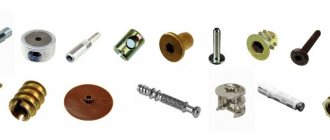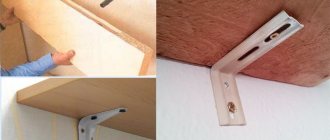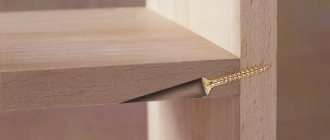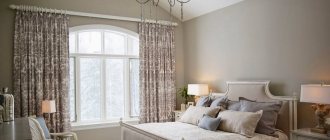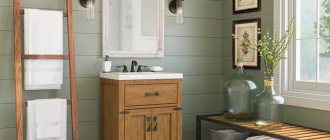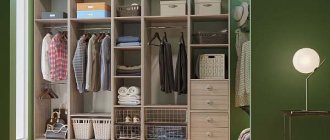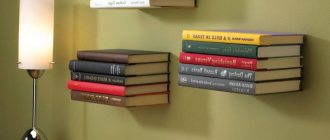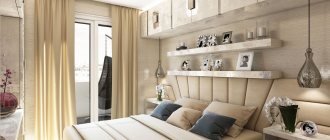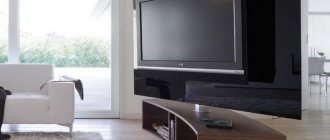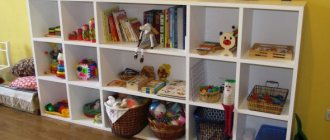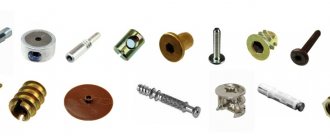A furniture corner is a hidden element, with the help of which the elements of the sets are tied together. It is used in the assembly of both cabinet and soft products. This fastener is made of metal or plastic. The special design implies exposure to increased loads. Metal furniture corners are widely used, and the elements themselves may vary, so you need to be careful when choosing.
Types of fastenings for different shelves
There are three main types of shelves used in modern furniture:
- Wood. Material - chipboard or MDF. The most common type.
- Cup. They are made of tempered glass using special thermochemical treatment. As a result, additional strength is provided, which allows them to be used in furniture production.
- Net or wire. They have the shape of a metal frame in the form of boxes or baskets.
Today, shelves are made from almost any material, including glass.
There are other modifications to the shelves, such as folding, sliding or height-adjustable. However, no specially designed fittings (except hidden ones) are used for their installation.
Shelves can have various modifications, including with retractable mechanisms.
Criterias of choice
Properly selected high-quality fastening elements ensure the reliability of the furniture.
When choosing, you need to consider the following:
- what material are they made of?
- size;
- appointment;
- maximum withstand load;
- under what conditions it will be used.
Nowadays, corners are in demand fasteners. Therefore, manufacturers produce a wide variety of designs that differ in many respects. You need to be careful and choose quality products, adhering to their purpose. Only this will ensure a long service life of the connection.
Due to low strength, this type of connection is not used in the professional field. For domestic purposes, for example, for installing a countertop or assembling a cabinet base, it is suitable. Many modern metal models are additionally equipped with a plastic cap, which gives the connection a decorative appearance.
Holder for glass shelf in cabinet
There are two most common types of glass shelf supports.
Special supports have been developed for glass.
Classic, support
In general, they are a pin design and are structurally divided into two parts: secret and support. The first part is usually mounted on the wall. Support: Designed to directly support the top of the shelf. It is made in the form of a platform: simple, lined, with an installed plastic gasket or suction cup. Allows you to remove shelves without using tools.
Various modifications of classic supports may have different appearances.
"Pelican": plug-in, with lock
This type of fastening can have a different design, but in principle it also consists of two parts - secret and receiving. The hidden part allows you to install the fastener on the cabinet wall, and the receiving part contains a groove into which the glass is inserted and fixed with a lock. Installation requires a screwdriver or a special wrench.
Pelican owners look like this.
Attaching mesh shelves
These shelves are often used in kitchen cabinets or closets. If they are used in the kitchen, as a rule, for storing (drying) dishes, then to secure the shelves in a wall cabinet, special reinforcement may be required (in addition to the standard one or included in the kit), since in this case, shelves in grids are often used for storing shoes.
These shelves are used in kitchens to store utensils. This imposes its own demands due to the high load and increased dimensions. Typically, the holder is a latch with a fixed part for fastening and a groove for accommodating the frame wire.
As a rule, they are attached to the supporting part.
What is this
This is the name of a special type of fastening that is suitable for all operations during furniture assembly. When creating a corner, all technical parameters are taken into account - despite the structural simplicity, the products can withstand heavy operating loads. They can be of different types, with different areas of use and design.
This type of fastening is affordable and very reliable. For built-in pieces of furniture, it will serve as the main connection, which can be safely called universal. The only thing is that after installation work it will be clearly visible and does not always have a beautiful appearance. Plastic products look visually great, but they can withstand smaller types of loads. No new holes are required for their installation.
Installation work is carried out using self-tapping screws. The corners have the simplest possible design. This is a bent metal plate, where the bend is an edge, and the edges are shelves. The products have an unusual color or shape. They are used to make internal types of connections or find use for them as decorative fittings. Let us highlight several types of corners that are installed using nails, euroscrews or standard screws.
Furniture corner
This type of fastening is used to connect two parts. This is a rather fragile connection method, so it is used for fastening parts that should not be subject to heavy loads. Usually these are decorative elements, for example, the base of a cabinet or mezzanine shelves.
Figure 21. The furniture corner is used for fastening decorative furniture elements (plinths) and installing shelves. Made of plastic. Has a cover to hide the clasps. Self-tapping screws 16 mm long are used as fasteners.
Instead of metal corners, plastic ones are often used. They are no less durable, but have a more attractive appearance and the possibility of hidden fasteners. The corner of the cabinet is attached to two mating parts with two self-tapping screws. The lid is then suspended, thereby hiding the fasteners.
Figure 22. The corner of the cabinet is used for fastening lightly loaded furniture elements, as well as for installing decorative elements such as plinths, inserts, etc.
The furniture fasteners discussed in the article are the most common and frequently used, as they are the most versatile and easy-to-use types of fasteners. In the vast majority of cases, the types of furniture fastenings described are sufficient for assembling any furniture.
Manufacturing materials
These furniture pads can be made from various materials. The most popular are:
- metal corner for furniture is a stamped product of considerable massiveness. Equipped with stiffening ribs. There is a hole at one end and a groove at the other. A coupling and screws are used for fastening. Also, metal products can be presented in the form of one strip, which is bent at an angle of 90 degrees. Fastening is carried out with self-tapping screws, so it is considered easy to use.
- plastic corners are usually small in size, and standard self-tapping screws are used for fastening them. A plastic corner can only be used for fixing small and light structures.
All products fastened with corners can become loose over time, and these fasteners are considered not very attractive, as they often protrude and spoil the appearance of the rooms.
Plastic
Metal
Details and elements
How to make shelves in a closet or how to build a closet from scratch? Here are the answers to the questions:
Required tools:
- screwdriver;
- screwdriver;
- drill;
- hex wrench;
- roulette;
- pencil, square or ruler;
Parts for cabinet directly:
- laminated chipboard sheets with a width of 70 to 40 cm - for the frame and internal partitions (false sheets or panels 10 cm wide - for framing the contour along the top and side walls in the case of a built-in wardrobe when attaching elements to the wall);
- The same shelves for the wardrobe;
- doors with a sliding mechanism - usually 2 or 3 (you can order ready-made ones or assemble them yourself - all components are sold in stores);
To secure shelves in a finished closet or assemble a built-in closet, you will need the following parts:
- Pins. With their help, the frame elements are attached to each other;
- Furniture corners, eccentrics, shelf brackets or European screws. One of the options for attaching shelves to a frame or wall. With corners and Euroscrews - it doesn’t look very nice, it’s quirky - it’s more complicated, but the brackets for the shelves are practically invisible from both sides.
- Drawer guides;
- When choosing drawers, pay attention to the mechanism. The box should not completely unwind and fall.
- Drawer handles should not interfere with opening. To do this, handles are made in the wooden canvas or slots are left.
Installation
As an example, let's take a plastic corner equipped with a removable lid. It may seem like there is nothing complicated - just tighten the screws and you're done. But even this simple task has a little trick. If you screw the part incorrectly, it will not hold well and form a gap.
During installation, the first thing to do is determine the distance from the edge to the center of the hole. Each type of corner will have its own numbers, in this case it is 15 mm. Now you need to correctly position the parts being pulled together so that one rests on the other. It is convenient to make markings with a carpenter's square.
Marks on parts can be made with a pencil, but it is quickly washed off. Recesses made with an awl will do. Please note that you should set aside not 15 mm, but 16. The corner is installed opposite the hole and the self-tapping screw is screwed into it. If the recesses were made in advance with an awl, then screwing in the screws is easier. The finished connecting element will not adjoin the edge of the part, which is why 1 mm is left.
How do you install shelves in a closet?
The whole process can be divided into several stages:
- Performing markings. When performing this work, it is very important to monitor the horizontal levels. Therefore, this is necessary to prevent items on the shelves from moving around in the future. If the weight is distributed unevenly, it will increase the load on the fastener. This may cause the supports to break and the shelf to collapse.
- Choosing a mounting method. If you choose corner support as one of the easier options, use furniture corners. They make the connection stronger. The downside is that corners cannot be hidden.
- If aesthetics are of paramount importance to you, you should choose a non-standard method - the "helicopter" method. This method involves the use of Euroscrews (three in total are required).
- Screw the screw into the center of the first floor, secure it to the partition, but do not tighten it too much. Rotate the surface 180º around the longitudinal axis to find a point to secure the adjacent element.
- Secure the adjacent frame with the remaining two screws. Try to lift them well, then return the first plane to its normal position.
- Fully tighten the shelves from the outside of the frame.
If any point remains unclear, look at the photos on our website to understand the situation, do the job efficiently and equip the cabinet with side shelves. The result is a durable and reliable structure that will last a long time.
Furniture screed is a special type of fastening used exclusively in the furniture industry. Such fasteners not only make furniture assembly much easier, but also become “invisible” after installation. In this article, we will look at the different types of fasteners that are used to assemble wooden furniture.
What to pay attention to
The choice of corners must be competent, therefore certain criteria are taken into account in the process of their selection:
- fastener material;
- product size;
- purpose, since certain structures may be intended exclusively for working with wood, while others are universal;
- the weight that the fasteners must withstand, since they must cope with their main task;
- terms of Use.
Thus, furniture corners are quite popular fastening structures. They come in different types and are also distinguished by a variety of factors. It is important to choose fasteners wisely so that they can withstand a certain weight and have a long service life, ensuring a strong screed.
Installing shelves in a closet: types of fasteners
Furniture fittings vary both in purpose and in the nature of the connection provided.
Shelf fasteners vary in purpose and type of connection. According to their intended purpose, fasteners are:
- Frame.
- Assembly.
- Power.
According to the nature of the connection:
- Collapsible.
- Doesn't add up.
Typically, fastening involves the use of tools such as a drill, Forstner cutters, countersinks, screwdrivers, hex keys, chisels, and wood glue. In addition, some types of fastenings require the use of very specific tools, which limits their ability to be used (Lamello Invis tie).
Tools are needed to attach the shelves.
Before choosing the type of fastening, you need to carefully consider the nature of the cabinet's use, so that in the future you can ensure trouble-free maintenance of individual elements or complete disassembly.
Euroscrews (Euroscrews, confirmats)
Used for joining elements of wooden furniture (chipboard, MDF). Such fasteners for a shelf in a closet require a wall thickness of at least 16 mm. Confirmations are made in a specific length range from 20 to 70 mm.
The wall for this mounting should not be thinner than 16 mm. Preparing the hole requires special drills with a countersink in the base and special keys to hold it in place. They are relatively easy to assemble, but may not fit all types of furniture since the screw head remains exposed. In addition, Eurovits do not allow organizing the longitudinal arrangement of shelves at the same height in the presence of vertical jumpers. Such fastenings are quite reliable.
Fastenings for shelves in the closet: rastex (minifix)
This equipment belongs to the so-called eccentrics, which indirectly indicates their principle of operation. This type of fastening provides good joint strength, but is difficult to manufacture, as it requires high drilling accuracy. Structurally, it consists of a bushing for the pin (footer), the pin itself and a pressure bushing.
This is what Rastex frames look like. The footer is installed into the furniture wall in a pre-prepared location. A pin is screwed into it. For shrink wrap, the cutter selects a piece of wood to fit the shelf. A hole for the pin is made perpendicular to it at the end. After assembling the connection, the bushing lifts the pin and secures it thanks to the groove in the side wall (hence the ex src=»https://pro-dom-mebel.ru/images/wp-content/uploads/2020/07/sverlenie-dlya-rasteksa .jpg" class="aligncenter" width="1500″ height="1143″[/img] This fastening requires precision drilling skills. Such a connection has two significant drawbacks: it cannot be used in a finished frame, and when marking it, it should be taken into account that when fastening the shelf can be moved in the plane.
Conical coupler
In this case, installing shelves in a cabinet is similar to installing them using a minifix. In addition, their circuit diagram is also quite similar: both have a footer, a pressure sleeve and a pin. The only difference is the storage method.
This is what conical screws for fastening look like. If this is provided in the raster using a groove in the bushing body, then fastening here is carried out with a special conical screw, which, screwed into the cavity of the bushing, enters the corresponding hole at the end of the pin and tightens it, thereby creating the necessary tension.
Screw tie
Typically, such fastening is used to extend (join) shelves, especially in the presence of vertical walls. This solution provides both a fairly convenient installation method and high reliability. This can be considered a further strengthening of the frame.
The screw clamp is easy to install and reliable. The concept of this solution is extremely simple: using a utility knife, a piece of wood is cut out from the edge of the shelf, forming a recess. A similar one is formed on another shelf. A hole is drilled in the wall large enough to accept a grub screw or screw. Specially shaped staples with a side hole are inserted into the grooves. The pin is inserted into the clamps and then tightened with nuts on both sides.
Fastenings for shelves in the closet: Rafix
Another representative of the eccentric type, but unlike the minifix, it does not require drilling the end channel. The circuit diagram is approximately the same, only the pin is held in place by a special screw.
This is what Rafix furniture frames look like. The choice of sleeve is made at the edge of the shelf, so that after machining with a router, the end is provided with a sufficient hole for the passage of the pin, which is installed on the cabinet wall. Next, a shelf with inserted bushings is put on the pins. Fastening is carried out by tightening the bolts. The disadvantages of Rafix include the inconvenience of installation, especially with low shelf heights.
Shelf holder
The simplest option, and no less effective for attaching shelves. Structurally, it differs between mortise and hinged. The insert involves a pin piece with which it is installed inside the wall. Hinged - fixed with self-tapping screws or glue.
Shelf supports can be mortise or hinged. With this method, the shelf sits freely on supports (under its own weight), which makes it easy to disassemble if necessary. Structurally, a typical support for a shelf in a closet can be equipped with a built-in platform with spacers or a special protrusion to prevent the shelf from moving towards the door.
The convenience of such stands is that the shelf can be easily disassembled at any time.
Dowel
The same pin, only made of wood, is the oldest way to connect furniture. Structurally, it is a small (20-30 cm long) chop with waviness along the side surface. The connecting parts of the frame (or shelves) contain coaxial inlet and outlet holes so that a pin installed at the end of the shelf fits into a hole in the cabinet wall.
The wooden dowel has the shape of a small chop with grooves along the side surface. In principle, installing dowels is enough. However, for the reliability of the connection, as well as to strengthen the frame, adjacent ends are additionally glued (sometimes confirmations are screwed in). An obvious disadvantage of this type of fastening is the difficulty of disassembling. As a rule, such fasteners for shelves in a closet are used in non-demountable structures. The disadvantage of such an attack is the difficulty of dismantling the shelves.
Corners
Also a simple and at the same time reliable type of fastening hardware. They differ in both design (in details) and material of manufacture. Of course, it is better to install metal corners, as they are stronger and more durable. However, they have one significant drawback - their appearance.
Corners are simple and reliable accessories for attaching shelves. Since the installation of corners both on the wall and on the shelf is done with self-tapping screws, this may not always be acceptable. In such cases, the installation of shelves in the closet is carried out using open or closed plastic corners. The closed type lid has a special cover that hides the less aesthetically pleasing interior.
However, recently metal corners have begun to be supplied with decorative covers.
Characteristics
The furniture corner has a standard and simple design. It consists of one plate, characterized by a bent shape. The place where there is a bend is a special edge, but the edges of such a plate are called shelves. There may be different angles between these shelves, since certain situations require products with obtuse, right or acute angles.
Furniture corners are created from various materials, but metal structures are considered the most popular, as they are characterized by a long service life, high strength and reliability.
These designs are used for different purposes:
- creating a tight internal connection of individual elements, so the products are indispensable in the furniture assembly process;
- use as a decorative element, for which special decorative corners are used;
- decoration of various shelves or racks, as well as all kinds of drawers;
- A protective corner for furniture ensures the creation of optimal conditions for the long service life of interior items.
If a decorative furniture corner is used, it can have a variety of unusual shapes, and is also certainly painted in different colors, but gold-plated and silver-plated fittings are considered the most popular.
Such products are used for different types of interior items. They are equipped with upholstered furniture or cabinet and modular structures. The most popular are metal furniture corners, made of steel or aluminum. They are usually coated on top with zinc, which provides effective protection of the fasteners from the corrosion process. If such a screed is used under normal conditions, when it is not affected by various negative factors and high humidity, then it will last a long time, maintaining its parameters and optimal appearance.
Dimensions and other parameters depend on what specific material and design it will be used for. This is due to the fact that fasteners must cope with a specific load and weight. Be sure to make symmetrical holes for the product on both sides, otherwise it will be skewed and therefore will not cope with its purpose. A furniture corner is considered one of the simplest fasteners, so not only professionals, but also beginners can effectively use it in the process of creating various structures.
The main characteristics of the element include:
- versatility - there are no special requirements for the place where the corner can be attached. It can be mounted in any corner, and does not require the use of complex connecting elements or specialized tools. It is only important to choose high-quality screws or other screw fasteners that can be equipped with washers and nuts;
- high reliability of the connection - the furniture corner can be used for assembling various structures. It is suitable for fastening shelves or other products on which a variety of heavy objects can be located, and at the same time the fasteners will perfectly cope with all loads. If you choose a reinforced furniture corner, it will not only withstand a significant weight, but will also have special protective coatings that prevent the corrosion process;
- Such components are produced in numerous sizes and shapes, so the optimal design is selected for each specific fastening. It can be used for different materials and products.
Thus, such a tie of different products as a furniture corner is a universal and popular design that has numerous advantages. It can be used for different fastening areas.
Through fasteners (with drilling) for confirmations
Confirmations are most common through closing shelves. To install, you will need to drill a hole in the end of the shelf with a diameter of 5 mm and on the front side of the side wall of the bedside table with a drill with a diameter of 8 mm. It is best to use a special confirmation exercise. Because it also requires a countersink under the confirming head to “sink” the screw itself flush with the surface of the side wall. In addition, the cap is hidden by a special self-adhesive cap, matched to the color of the chipboard.
Gradient - depending on the thickness of the side walls, the length of the confirmation is selected. For standard thickness of chipboard and MDF 16-18 mm, a 5x50 Euro screw is used, for thicker panel materials - a longer one, up to 70 mm.
- Among the advantages of attaching shelves to confirmations, it is worth highlighting the ease of assembly and the low cost of the fastener itself.
- The downside is that it requires drilling. Not everyone likes the “losing” aspects of furniture in an aesthetic sense. Self-adhesive dowels, although color-matched, are still visible. In addition, furniture assembled by confirmation no longer “values” assembly and disassembly.
Hidden
Hidden support for shelves is a solution for interiors in high-tech, minimalism or modern style.
To install shelves on the wall use:
- Hidden loops. They are suitable for products of different thicknesses and from different materials (chipboard, solid wood, plywood). Using a building level and a marker, mark points on the wall surface and drill holes for fasteners. Then the dowels are inserted and the rings are fixed to the self-tapping screws. At the end of the shelf with which it will be connected to the wall, it is advisable to make a recess to the size of the ring so that there is no free space between the wall and the shelf due to protruding joints.
- Metal rods. This type of fastening applies to the console. Usually it is sold complete with the shelf itself, in which holes of the required diameter and depth are already drilled. The mounting method can be different: screwed to the wall with a dowel or mounted on flat hinges or strips. Reliable fastening is guaranteed only by fittings with a diameter of at least 10 mm.
- Wooden beam. Used for installing closed shelves. Using a level and a marker, draw a line on the wall along which the auxiliary fasteners will be placed (it should go under the shelf). Then the plank is fixed with dowels and screws. Hang the shelf and secure it with an additional strip.
What is it for?
In the field of furniture production, there are many types of fasteners, which differ in size, shape and other parameters. A furniture corner is a basic piece of furniture in the form of a consumable. A high-quality corner can provide a tie between 2 flat furniture elements, and they can be made of 2 different materials, for example, metal or wood. To fasten it to glass, you need a specialized pad.
Where are they used?
- Due to the protective qualities of such an element, the fastenings remain reliable for a long time.
- They will serve as decoration for various racks and shelves, as well as various drawers.
- They create an internal tight connection of structural parts from the same or very different materials.
Furniture corners are suitable for modular and cabinet structures.
Features of fastening shelves depending on the type of wall
When installing fasteners for shelves to the wall, it is necessary to take into account the characteristics of the material from which the base is made. The higher its strength, the more reliable the attachment of the hinged structure will be. Soft wood and fragile drywall surfaces do not provide adequate support. Methods for attaching shelves and the type of fittings used vary.
Concrete wall
To drill a hole in a solid concrete surface, you will need a hammer drill. The work must be carried out using a special drill for concrete, the diameter of which is selected based on the size of the dowel. The depth of the hole should correspond to the length of the fastener.
The drill is placed at a right angle; at the slightest inclination, the diameter of the hole at the entrance will increase, and therefore the dowel and self-tapping screw will not be firmly secured. This may cause the shelf to fall later.
Metal corners for furniture: types, properties and how to choose
Technical properties
Decorative metal corners for furniture, made of steel or aluminum, are in great demand. They are coated on top with zinc, which is required to protect against corrosion. If this screed is in standard conditions, that is, it is not affected by negative factors, then it will serve for many years without changes in operating properties. The dimensions and other properties of the fittings are taken into account depending on the material of manufacture and design features. Each type of mount can support a limited amount of weight and load. It has 2 symmetrical holes on both sides, which helps prevent skewing. Decorative furniture corners are used by both experts and beginners in the manufacture of all kinds of designs. Product properties:
- Highly reliable connection - they are used to assemble all kinds of structures, and also attach shelves or other products on which heavy objects will be placed. We will separately highlight a reinforced version for furniture, which is equipped with a specialized coating that protects against corrosive effects and at the same time can withstand significant loads.
- Versatility - suitable for different types of connections, and during installation there is no need to drill holes, which is why the front panel side will be untouched.
- A huge assortment - components differ in shape, color, and also the presence/absence of a decorative cover. This makes it possible to choose the best option that suits all the characteristics of the interior design of the room.
It turns out that this design is popular and universal and has many advantages. It can be used for different installation areas.
Varieties of corners according to purpose and size
At the moment there are different furniture fittings (metal corners) of different sizes. When choosing a specific size, you should take into account the expected materials and loads from which the connection elements are made. The size of the corner will depend on its purpose.
Main types:
- With a locknut - these are perforated and reinforced modifications.
- Reinforced - they are used by qualified workers in the field of construction.
- Perforated - specialized holes make it possible to install them using high-strength hex bolts, and such products are also used to secure rather heavy structures.
- For corner-type connections of heavy beams, they are installed in both vertical and horizontal planes. Dimensions vary from 4*4*6 to 10*10*10 cm.
- For easy connection, the thickness of the products is 0.2 cm and the dimensions are 4*4*2 cm. This type of tie is suitable for installing small shelves and similar structures that will not be loaded with heavy objects.
Each type of fastening has a specific purpose, and there is no point in using reinforced elements to hang a simple shelf, because the expense will be inappropriate, since you will not receive additional benefits.
What materials are they made from?
The furniture corner is most often made of plastic or metal. Each material has its own properties, which will affect operating conditions.
Metal
If metal is used to create a corner, then the final product will be a stamped solid product. The design involves a hole on one side and a groove on the other. An element for this type of connection can take the form of solid boards that are bent at right angles. They are attached using self-tapping screws, which made them easy to use. Due to the stiffening ribs, their load-bearing capacity will increase, and metal parts are also used in the manufacture of new pieces of furniture or repair of old ones. Fasteners are made from high-quality carbon steel, which is additionally coated with zinc for protection. Metal corners can be used to fasten tabletops, shelves, plinths, bars, etc.
Plastic
In addition to metal corners for fastening furniture, there are also small plastic products. Secure with self-tapping screws. Using plastic corners it is permissible to secure only small and not very heavy structures, which can be explained by the properties of the material. The plastic bracket can be mounted both on the outside and in a hidden place of the furniture frame. They produce single and double models, complete with decorative plugs. Their colors come in beige, white, gray, black, dark brown and red-brown, which allows buyers to choose a piece that matches the shades of the interior items.
Accessories for rotating shelves
Rotating shelf accessories include:
- upper and lower fixation of the rotation axis;
- the axis of rotation, which is a telescopic metal tube, that is, the height of the pole can be changed according to the dimensions of the cabinet;
- flange mounting bracket.
Installation of a rotating shelf
To install the rotating shelf correctly, you must:
- choose a place to attach the rotation axis so that the installed shelf can move freely inside the cabinet;
- secure the upper and lower connecting structures (simply screwed to the lower and upper parts of the cabinet, respectively);
- install the pin by inserting the pipe into the fixed flanges;
- screw the shelf support to the board;
- install the shelf itself.
The rotating shelf is installed correctly
Therefore, when choosing accessories for shelves, you should proceed from the material from which they are made and the method of fastening the product. In stores you can find many different options for overhead, mortise supports, sliding and rotating mechanisms, the independent installation of which does not cause any difficulties.
Installation
As an example, let's take a plastic corner that is equipped with a removable lid. At first it may seem that nothing is more complicated - screw in the screws and you're done. But even simple tasks have their subtleties. If the part is screwed incorrectly, it will not hold well and create a gap. When installing, the first thing to do is determine the distance from the center to the edge of the hole. Each type of corner has different numbers, in our case it is 1.5 cm. Next, correctly place the elements being pulled together so that one rests on the other. The easiest way to mark is using a carpenter's square. Marks on elements can be made with a pencil, but they will quickly be erased. Indentations made with an awl will also work. It is worth paying attention to the fact that it is worth setting aside not 1.5 cm, but 1.6 cm. The corner should be installed opposite the hole and screw the self-tapping screw into it. If the recesses were previously made using an awl, then screwing in the screws will be easier. The finished connection element will not adjoin the edge of the element, and therefore leaves 0.1 cm. We invite you to watch a video that provides information on corners for furniture.
Fixing the shelf on the wall using hidden fasteners
Step 1. To attach the shelf to the wall using a secret fastening option, you will need to prepare a hammer drill with a drill of a certain section, 2-3 special titanium pins, a building level, a square, a drill and a drill, the shelf itself, and mark a pencil. The pin is a metal rod with a thread on one side and smooth on the other. Using the threaded part, it will be screwed to the wall and the shelf will have to be placed on the smooth part. Typically the diameter of the pin is 10-12 mm. The drill is selected with the same diameter as purchased titanium.
Special metal pin
Step 2: First, label the shelf itself. By the way, you can make it yourself from any other piece of furniture that has served its purpose, and not buy a new one. Using a ruler, you need to take the required distance from the end edge of the shelf. In this case, a distance of 12 cm was chosen.
Marking
Step 3. Having chosen the distance, use a square and a pencil to draw a line perpendicular to the plane of the shelf at the end where the hole for fasteners will be drilled.
At the end a perpendicular line is drawn
Step 4. Next, you need to find the center of the end of the board and make a corresponding mark for the drill. It is important to understand that if the shelf consists of two sheets of chipboard glued together, it is better to make the hole for fastening not in the center, but with a slight offset to one or another board (better down, it will be safer).
Marked for drill
Step 5. A similar mark must be applied to the opposite side of the shelf.
On the other hand, the same signs apply
Step 6. Next, at the end of the shelf where the marks are made, you need to attach a building level and directly on it make marks parallel to those previously applied to the panel, and also mark the edges of the shelf itself. The layer cannot be moved when the markup is transferred. The pencil marks can be easily erased from the flat surface later, but this method of transferring marks will make it easier to make marks for drilling holes in the wall.
The layer cannot be moved when moving elevations
Markings are made at the level
Step 7. Then you need to choose the approximate location of the shelf on the wall. After application to the surface, you must use a pencil to mark the boundaries of the product directly on the background.
The shelf is attached to the wall
Shelf limits are marked
Step 8. Now you need to take a building level with marks and, gluing it to the wall in a selected and marked place, align and transfer the marks from the level to the wall, also with a pencil. This makes it easy and quick to accurately mark pin holes without unnecessary movements.
Transferring marks from level to wall
Step 9. Next, at the end of the shelf in the designated places, you need to drill holes for the pins. They should be the same depth as the length of the part of the pole on which the board will slide.
Eventually a hole is drilled
The depth of the hole should correspond to the part of the pin on which the shelf will be placed
Step 10. Now you need to take a hammer drill with a drill of the same diameter as the pin and drill holes in the wall according to the previously marked marks. To prevent concrete dust from falling onto the floor, it can be removed immediately using the included vacuum cleaner, from which an assistant will hold the hose.
Holes are made in the wall
Step 11. Both titanium rods must be installed in place, that is, inserted into the holes in the wall. If they are difficult to insert, they can be carefully knocked out with a hammer or screwed to the wall with a wrench.
The pins are inserted into the holes
Step 12. All that remains is to place the shelf on the studs in the wall, aligning the holes with the metal fasteners. The shelf is installed. By the way, for better fixation, you can add a little glue to the holes of the shelf, then the connection will be even more reliable. This mounting option will allow you to achieve an effect where it seems that the shelf will be held against the wall.
The shelf is installed on studs in the wall
Finished shelf without visible fastenings
Video - How to install a shelf with invisible fasteners
Sources
- https://severdv.ru/mebel/polki-i-stellazhi/kak-krepit-polki-v-shkafu/
- https://csdesire.ru/mebel-interier/mebelnaya-styazhka-58.html
- https://AmiPlus.ru/zona-otdyha/bokovye-polki-k-shkafu.html
- https://englishpromo.ru/2019/12/kreplenie-polok-v-shkafu-bez-vidimogo-krepezha/
- https://kraska.guru/dom/xozyajstvo/polki-v-nevesomosti-paryashhaya-konstrukciya-bez-vidimogo-krepleniya-na-stene.html
- https://MebelRus64.ru/polki-i-shkafy/kak-sdelat-dopolnitelnuyu-polku-v-shkafu.html
- https://shkaf-info.ru/kreplenie-polok-v-shkafu-obzor-vozmozhnyh-variantov/
- https://KrepezhInfo.ru/ustanovka-polok-so-skrytym-krepleniem/
- https://infomebli.ru/gostinaya/shkafi/krepim-polki-svoimi-rukami.html
- https://papa-carlo.su/materialy/dsp/kak-krepit-polki-v-shkafu.html
- https://udobno77.ru/kak-prikrepit-polku-mezhdu-shkafami/
- https://dd-space.com/chastye-voprosy-professionalov/mebelnye-krepezhi/
- https://mebel-expert.info/kreplenie-polok-k-stene-bez-vidimogo-krepezha/
- https://MebSam.com/vidy-mebelnyh-krepezhej.html
What materials are they made from?
The furniture corner is made of metal or plastic. Each material has its own characteristics that affect operating conditions.
Metal
If metal is used to make the corner, then the final product is a massive stamped product. The design involves a hole on one side and a groove on the other. Connecting elements of this type can also take the form of a single strip, bent at an angle of 90°. They are attached using self-tapping screws, which makes them easy to use.
Thanks to the stiffening ribs, their load-bearing capacity increases. Metal parts are used in the production of new furniture or repair of old ones. They are made from high quality carbon steel, which is additionally coated with zinc for protective purposes. Metal corners are used to fasten shelves, tabletops, beams, plinths, and so on.
Plastic
As a rule, these are small-sized products. Fastened with self-tapping screws. Using plastic corners, it is allowed to fix only small and not too heavy structures, which is explained by the properties of the material.
The plastic bracket can be installed both on the outside and in the hidden area of the furniture body. Single and double models are available, with decorative caps included. Their color can be: white, beige, dark brown, gray, red-brown and black, which allows the buyer to choose the detail that matches the interior items.
